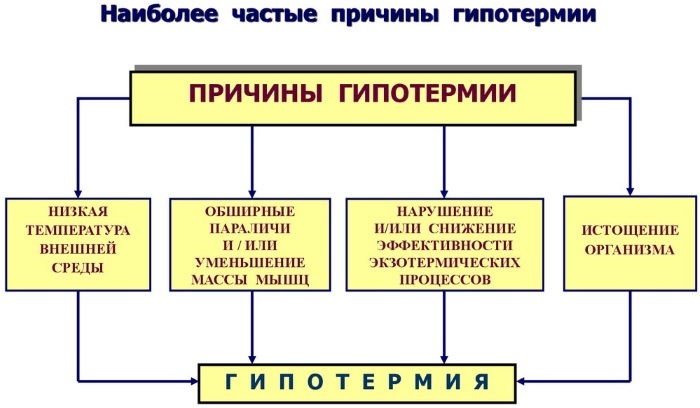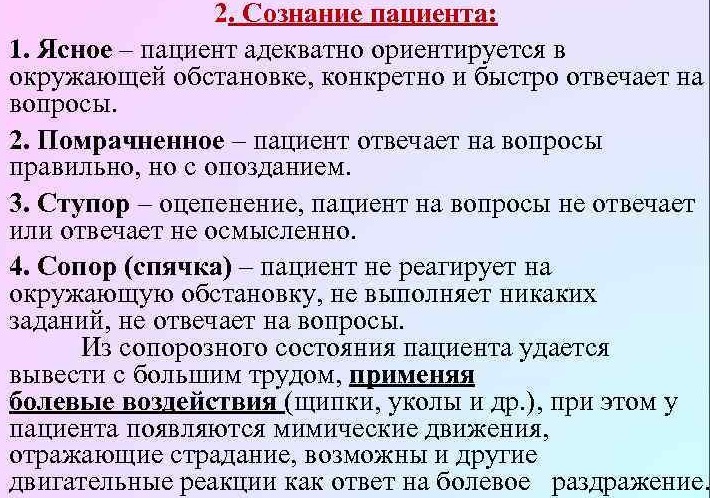The problem of abuse of various substances (drugs, alcohol and nicotine) is currently very acute. This threatens not only the health of the population, but also carries the risk of dangerous complications. Among which is an important place takes withdrawal symptoms. This is a condition that requires mandatory medical intervention, as it threatens a person's life.
Record content:
- 1 What is withdrawal symptoms?
- 2 Views
- 3 How is it developing?
- 4 What is neonatal withdrawal syndrome?
- 5 Causes and treatment
- 6 Symptoms by stage for alcohol poisoning
- 7 When quitting smoking
- 8 When giving up drugs
- 9 Withdrawal Syndrome Treatment
- 10 Withdrawal videos
What is withdrawal symptoms?
Withdrawal symptoms are a combination of symptoms that occur against the background of abrupt withdrawal or gradual reduction in the dose of a certain substance.
This syndrome is characterized by disorders of the nervous system, the mental state of the patient, and is also characterized by disorders of the functions of internal organs. The degree of manifestation depends on many factors, including the dose of the substance consumed.
Such a pathological condition can develop not only in adults, but also in newborn children.
People suffering from alcoholism, drug addiction, nicotine addiction are susceptible to the development of pathology. But it is also possible to develop pathology against the background of taking medications. Especially in those patients who have been treated with them for a long time.
Views
The main types include:
- Alcohol withdrawal. Caused by a sharp refusal from alcohol after prolonged use. It can develop with continuous alcohol intake for a week.
-
Narcotic withdrawal symptoms. It develops as a result of refusal from drugs or if it is impossible to take a new dose. In another way, this condition is called "withdrawal".

- Nicotine withdrawal symptoms. The manifestations of this syndrome are milder than those of other addictions. Does not require specific treatment. It develops due to the gradual or abrupt cessation of smoking.
- Withdrawal syndrome of newborns. This pathology develops in children whose mothers abused harmful substances during pregnancy. In turn, the general concept of the syndrome is divided into alcohol syndrome and opioid withdrawal syndrome of the newborn.
How is it developing?
The mechanism of development is based on the action of certain receptors of the nervous system. Under the influence of substances, these receptors appear as if in a "dormant" state. And when canceled, their sharp activity arises, which leads to the development of psychomotor agitation.
This is especially true for alcohol withdrawal symptoms. Subsequently, the receptors begin to send a signal to the brain about the need for a substance. Because of this, there is a "withdrawal" and an urgent need for a person to use the substance.
What is neonatal withdrawal syndrome?
Withdrawal syndrome is a set of clinical manifestations when drugs or alcohol cease to enter the body of a newborn child.
The following types of withdrawal syndrome are distinguished:
- Alcohol syndrome.
- Opioid Syndrome.
With the development of alcohol syndrome, the first signs appear 2 or 3 days after delivery. As a rule, the child is hyperactive, does not sleep well, is restless, appetite may be disturbed. And also a clinical manifestation can be a loud crying of a child and the inability to calm him down.
Approximately on the fourth day after childbirth, the child becomes apathetic, drowsiness increases. Prolonged regurgitation after feeding is possible. Sleep is disturbed, appetite suffers. This period is not characterized by loud crying of the child, since he is in a state of sleep almost all the time.
Opioid syndrome develops as a result of the mother's use of drugs during pregnancy and immediately before childbirth.
Clinical manifestations develop acutely, 1 or 2 days after childbirth. The child is restless, screams, appetite is disturbed. The sucking reflex may be completely absent. And also there is trembling of the lower and upper extremities, bulging of the fontanelle.
Common clinical symptoms for all types of neonatal abstinence include:
- Loud piercing cry.
- Restless sleep.
- Trembling of the upper and lower limbs and head.
- Dyspeptic disorders (frequent regurgitation, vomiting, diarrhea, or constipation).
- Poor appetite.
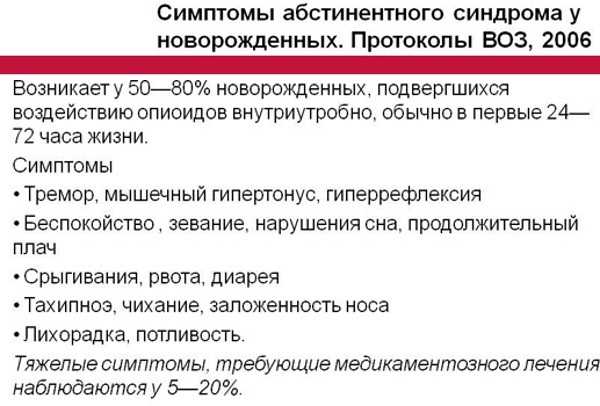
- Increased sucking reflex.
- Increased body temperature.
- An increase in the size of the liver.
- In the blood, an increase in the amount of bilirubin. As a result, jaundice develops.
- Convulsions.
- Decrease or increase in the number of heartbeats.
- An increase in the fontanelle.
- Small weight gain.
- Cyanosis of the lower extremities and nasolabial triangle.
- Lachrymation.
- Rhinorrhea.
- Hypertonicity of muscles.
Withdrawal syndrome in newborns is a severe pathology. The severity depends on the amount of substances that the mother consumed during pregnancy, as well as the time interval from their intake into the body until delivery. The higher the dose and the closer to childbirth it was taken, the prognostically worse prognosis for the child.
The condition is assessed using a special Finnigen scale. Diagnosis is usually not difficult. But sometimes some research may be required.
These include:
- Collecting anamnesis from the mother (how the pregnancy proceeded, whether she took illegal substances, alcohol).
- Child's blood test.
- Ultrasound of the brain.
Differential diagnosis is carried out in combination with a number of other pathologies of intrauterine development: intrauterine pneumonia, hydrocephalus, malformations of the child's organs.
The prognosis in children who have undergone abstinence is unfavorable. The reason is that these patients have an increased risk of developing chronic diseases, including including on the part of the cardiovascular and respiratory system, the central nervous system and the head brain. And also in this category of patients, cognitive impairments and mental retardation are more often diagnosed.
In this group, children under 1 year of age had frequent cases of sudden infant death as a result of sleep apnea (respiratory arrest).
In adolescence, the formation of aggressive and asocial behavior is possible.
Causes and treatment
The reasons for the appearance of abstinence in newborns are uncontrolled intake of drugs or alcohol by the mother of the child. The main reason for the severity of this syndrome is drug use shortly before childbirth.
Nicotine addiction also affects the development of the fetus in the prenatal period, but does not occur in the form of withdrawal symptoms.
Treatment for newborns begins with clarifying their HIV epidemic status. Mothers who use drugs often have this disease, which is transmitted vertically (from mother to fetus).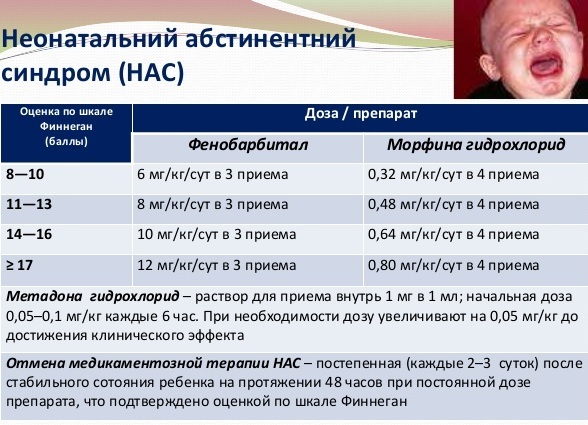
Based on this, the following treatment is prescribed:
- Taking antiretroviral drugs. Without a damaged diagnosis in prophylactic doses.
- The introduction of phenobarbital (at the maximum dose with the development of seizures). This drug is prescribed orally.
- In case of ineffectiveness of treatment or severe course, phenobarbital and morphine are used in combination.
- Symptomatic therapy. It includes the treatment of concomitant pathologies, correction of the water-electrolyte balance, as well as the maintenance of the vital functions of the child.
- Conducting maintenance therapy with phenobarbital, gradually reducing the dosage of the drug to the minimum.
Against the background of the treatment of withdrawal symptoms, special attention is paid to monitoring the indicators of the child's cardiovascular and respiratory systems. In case of changes, the patient is transferred to the neonatal intensive care unit.
Signs of the effectiveness of the therapy are:
- Sleep normalization, disappearance of pathological drowsiness.
- Normalization of body temperature.
- Reduction or disappearance of signs of jaundice.
- Normalization of muscle tone.
- Weight gain.
- Reducing the excitability of the child.
Symptoms by stage for alcohol poisoning
The clinical manifestations of alcohol poisoning depend on many factors.
These include:
- Alcohol poisoning stage.
- The age of the patient. The younger the person, the more severe the symptoms.
- Floor. Women are more likely to experience severe alcohol poisoning.
- Body mass. The lower the weight, the more severe the symptoms will be.

Alcohol withdrawal syndrome 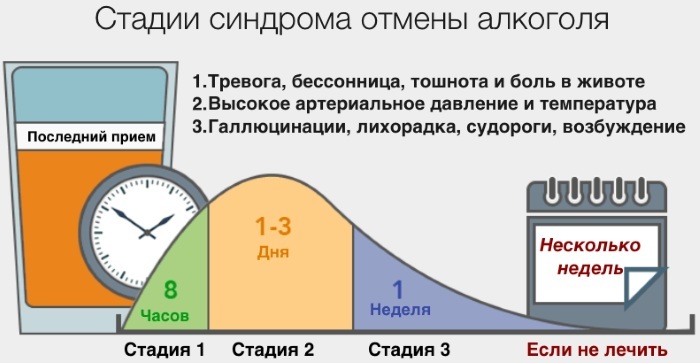
Withdrawal symptoms also occur with prolonged alcohol abuse.
At the same time, there are 3 stages of alcohol syndrome:
| Stages of alcohol syndrome | Clinical manifestations |
| 1 | At this stage, the patient does not notice any pathological manifestations in himself. |
| 2 | The person experiences psychomotor agitation, hallucinations are possible. The patient experiences severe tremors in the upper and lower extremities, headaches. The tongue becomes covered with a gray coating, the skin acquires a hyperemic shade. The gait is shaky, the person loses balance and experiences severe weakness. In addition, the patient experiences nausea and vomiting, bitterness in the mouth and loss of appetite. An increase in the size of the liver and the appearance of pain in the right hypochondrium are possible. Diarrhea and abdominal pain are common. |
| 3 | The patient is apathetic, lethargic, inhibited. The skin is pale, profuse cold sweat appears, facial features are pointed, cyanosis of the lower extremities is observed, coordination of movements is impaired. On examination, the pupils are dilated. |
When quitting smoking
With nicotine addiction, the symptoms are not life threatening. Pathological disorders are primarily manifested in the emotional sphere.
The following symptoms are observed:
- Deterioration of health (lethargy, apathy).
- Irritability.
- Headache.
- Noise in ears.
- Increased blood pressure.
- Trembling in the limbs.
- Poor appetite.
- Nausea and vomiting.
- Sleep disturbances.
All these manifestations can be observed in a complex manner, or they can be observed separately. It depends on the smoking history, age and condition of internal organs.
As a rule, an improvement in well-being occurs after a week without the use of any measures.
It is recommended to lower the nicotine dose gradually and not to quit smoking too abruptly. It may take time to get rid of a bad habit, and during this you can use special nicotine patches, in which the nicotine content is much lower than in cigarettes.
When giving up drugs
The severity of withdrawal from drugs is much more severe than from other substances. This is due to a strong psychological dependence on drugs. In addition, few patients in drug treatment clinics consciously refuse drugs.
The most severe manifestations are observed with the use of heroin. Inhaled narcotic substances have less pronounced symptoms.
When refusing narcotic drugs, the patient goes through several periods, each of which has its own characteristics. The first symptoms begin to develop 10 hours after the last drug intake.
| Stage | Clinical manifestations |
| Stage 1 (10 hours after the last dose) | psycho-emotional discomfort. A person feels a decrease in mood and performance. After a while, the apathetic mood changes to aggression, which can be directed at the people around. In addition, there is an increase in body temperature, intense sweating, skin itching, pain in muscles and joints, impaired appetite or its complete absence. |
| Stage 2 (after 24 hours) | Symptoms begin to intensify sharply, anxiety and aggressive behavior grow. On the part of the somatic state, pupil dilation, intense salivation and rhinorrhea occur. It is also possible to increase body temperature, cramps in the calf muscles. Appetite is absent when thinking about food, the patient may experience an intense feeling of nausea and even vomiting. Sleep is restless, the patient may notice that when trying to sleep, there is a feeling of falling. |
| Stage 3 | It is characterized by an increase in motor activity and psychomotor agitation, a person is constantly accompanied by an obsessive desire to use the drug. Dyspeptic disorders (vomiting, diarrhea, abdominal pain) are increasing. Appetite is rapidly deteriorating, the patient is losing weight dramatically. Pupils dilate and facial features sharpen. |
| Stage 4 | There is complete indifference to the outside world, alternating with bouts of aggression. At this stage, a person is ready for anything to get the next dose of a narcotic substance. Symptoms are generalized. Itching of the skin increases, especially along the vessels. Severe pain throughout the body does not allow to sit still, the patient rushes about, motor excitability alternates with episodes of complete indifference. Sleep is disturbed. The patient does not take food and liquids, exhaustion and dehydration occurs. |
Withdrawal syndrome is a pathology that, without medical intervention, can lead to very serious consequences for human life and health. And this applies not only to the return to taking narcotic drugs. When using drugs, a person feels the need to increase the dosage each time and this ultimately can lead to an overdose and death of the patient.
As a rule, death occurs from acute respiratory and heart failure. And also there is a high probability of death from opportunistic infections (HIV infection, AIDS).
Drug withdrawal symptoms can persist for quite a long time, usually from 7 to 14 days. Then, gradually there is an improvement in well-being.
But after a while, symptoms may return. And if a person cannot resist the desire to receive a dose, the weight will begin anew.
Therefore, it is very important, after the normalization of the general condition, to provide the patient with the necessary psychological assistance. For this, the patient is placed in a narcological hospital, where he is treated by a psychiatrist and a narcologist.
Withdrawal Syndrome Treatment
Treatment depends on the severity of the withdrawal symptoms.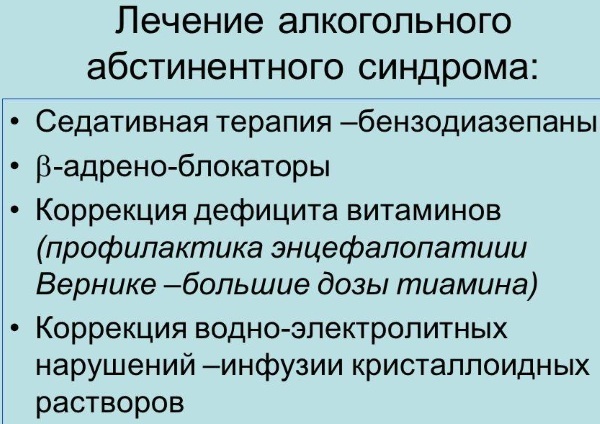
With an uncomplicated course, the following algorithm of actions is applied:
- Correction of the water balance in the body with the help of infusion therapy or plentiful intake of fluids inside.
- With severe anxiety, insomnia or mild psycho-emotional arousal, small doses of tranquilizers are used.
- Providing psychological comfort to the patient.
Withdrawal symptoms are a pathology that can lead to complications. If the manifestations of the syndrome are severe, then more serious measures should be used to treat it.
| Actions | Method of treatment and / or dosage of drugs |
| Hospitalization | It is carried out in the intensive care unit to maintain the vital functions of the body. |
| Therapy of concomitant diseases | Providing drugs for the cardiovascular, respiratory system, liver and other damaged organs. |
| Adjusting the water balance | Infusion therapy (saline, glucose). |
| Elimination of electrolyte imbalance (hypokalemia) | Administration of potassium and magnesium preparations. This helps to improve cardiac activity. |
| Maintaining the cardiovascular system | The use of beta-blockers (in the absence of alcohol in the blood). |
| Relief of the patient's psychomotor agitation | Administration of tranquilizers (diazepam) and psychotic drugs (haloperidol). |
| If convulsive syndrome is present | Intravenous administration of anticonvulsants. |
| With hallucinations | Intravenous benzodiazepam administration |
| Prevention of drug dependence | Gradual dose adjustment of drugs from the benzodiazepam group. |
| Improving the psycho-emotional state | Administration of antidepressants. |
| Consultation with specialist doctors | Control of a psychiatrist and narcologist. |
| If it is impossible to stabilize the patient's condition (with narcotic withdrawal) | Introduction to drug sleep, resuscitation measures. |
| Treating opportunistic infections (if any) | The introduction of antiretroviral therapy for a patient with HIV infection, as well as the use of prophylactic dosages (in case of questionable results of the study and if an infectious process is suspected). |
| Diet | If a person is unable to eat, feeding is carried out through a nosagastric tube with mixtures. |
At the stage of rehabilitation, it is very important to establish dynamic monitoring of patients who have had withdrawal symptoms. For this, they are supervised by a narcologist. The frequency of examinations is decided based on the type of addiction and severity.
The prognosis for the development of withdrawal symptoms depends on the severity of the patient's condition, as well as on the type of addiction.
With the development of the syndrome against the background of drug addiction, the prognosis is more unfavorable than in patients with alcoholism. Since it is possible to resume drug use and develop a new withdrawal syndrome.
In general, the successful treatment of withdrawal symptoms largely depends on the timeliness of medical care. This condition must be stopped as soon as possible. As a rule, with the provision of medical care, patients recover within 2-3 months.
Withdrawal videos
Withdrawal symptoms in alcoholism:

